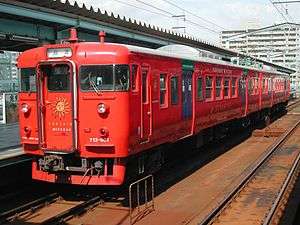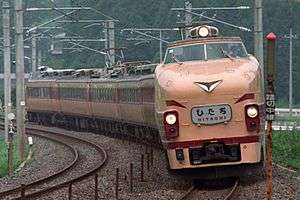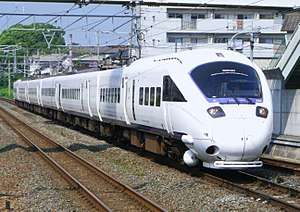713 series
| 713 series | |
|---|---|
 Reliveried set LK901 | |
| In service | February 1984–Present |
| Manufacturer | Hitachi, Tokyu Car |
| Constructed | 1983 |
| Refurbishment | 1996, 2008-2010 |
| Number built | 8 vehicles (4 sets) |
| Number in service | 8 vehicles (4 sets) |
| Formation | 2 cars per trainset |
| Fleet numbers | LK1–4 |
| Operator(s) | JR Kyushu |
| Depot(s) | Kagoshima |
| Line(s) served | Nippo Main Line |
| Specifications | |
| Car body construction | Steel |
| Car length | 20,000 mm (65 ft 7 in) |
| Width | 2,946 mm (9 ft 8 in) |
| Doors | 2 pairs per side |
| Maximum speed | 100 km/h (60 mph) |
| Traction system | Thyristor drive |
| Electric system(s) | 20 kV AC 60 Hz |
| Current collection method | Overhead catenary |
| Track gauge | 1,067 mm (3 ft 6 in) |
The 713 series (713系) is a Japanese AC electric multiple unit (EMU) train type first introduced by Japanese National Railways (JNR) in 1984 and later operated on local services by Kyushu Railway Company (JR Kyushu).[1][2] As of 1 October 2012, all four of the 2-car sets are still in active service.[3]
Operations
Based at Kagoshima Depot, the fleet of four 2-car 713 series trains are used on Nippo Main Line services.[3]
Formations
The 2-car sets, numbered LK1 to LK4, are formed as follows.[3]
| Designation | Mc | T'c |
|---|---|---|
| Numbering | KuMoHa 713 | KuHa 712 |
The KuMoHa 713 car is fitted with one PS101D lozenge-type pantograph.[3]
External livery
When delivered, the trains were originally painted in cream ("Cream No. 1") with green ("Green No. 14") bodyside bands, matching the 715 series EMUs.[4] Between 1986 and 1987, the sets were repainted in the standard Kyushu livery of white with blue bodyside bands.[2]
In 1996, the fleet underwent refurbishment and was repainted in a bright red "Sunshine" livery with blue doors.[2]
History
The 713 series sets were delivered from July 1983, built by Hitachi and Tokyu Car Corporation, and becoming the first AC-only EMUs to operate in Kyushu.[2] They entered service from the start of the February 1984 timetable revision, operating on the Nagasaki Main Line and Sasebo Line, and based at Minami-Fukuoka Depot.[2][4] Because of their somewhat experimental nature, the cars were originally numbered in the KuMoHa 713-900 and KuHa 712-900 series.[4]

Coinciding with the opening of the Miyazaki Airport Line on 18 July 1996, the fleet underwent extensive refurbishment and were transferred from Minami-Fukuoka Depot to Kagoshima.[2] Internally, the fixed transverse seating bays were replaced with pairs of new reclining seats which could be rotated to face the direction of travel.[2] Externally, sets received a new bright red "Sunshine" livery with blue doors.[2]
The fleet underwent further modifications to allow the sets to work on wanman driver-only operation services commencing from October 2003.[2]
Between 2008 and 2010, the fleet underwent a second life-extension refurbishment programme, primarily designed to standardize the electrical equipment built by different manufacturers. At the same time, the individual cars were renumbered from the -900 subseries to the -0 subseries, and the sets were renumbered LK1 to LK4.[2]
References
| Wikimedia Commons has media related to 713 series. |
- ↑ JR全車輌ハンドブック2009 [JR Rolling Stock Handbook 2009]. Japan: Neko Publishing. 2009. p. 309. ISBN 978-4-7770-0836-0.
- 1 2 3 4 5 6 7 8 9 10 Saka, Masahiro (February 2013). "JR九州近郊型電車の現況" [The current state of JR Kyushu outer-suburban EMUs]. Tetsudō Daiya Jōhō Magazine (in Japanese). 42 (346): 14–31.
- 1 2 3 4 JR電車編成表 2013冬 [JR EMU Formations - Winter 2013]. Japan: JRR. November 2012. p. 230. ISBN 978-4-330-33112-6.
- 1 2 3 国鉄電車編成表1985年版 [JNR EMU Formations - 1985]. Japan: JRR. October 2010. p. 83. ISBN 978-4-330-17610-9.

